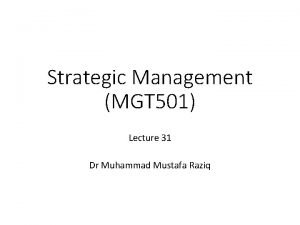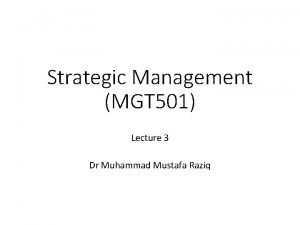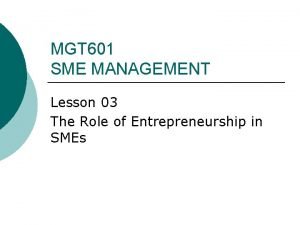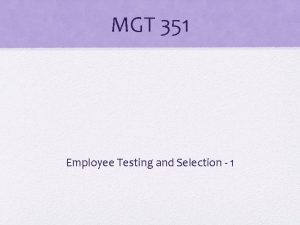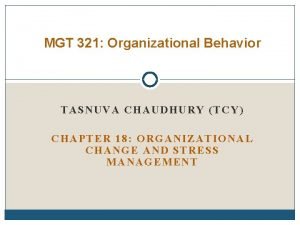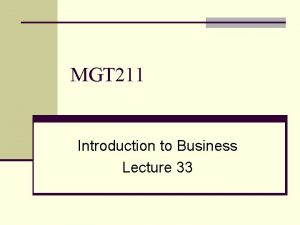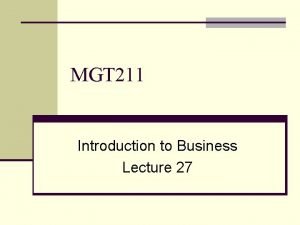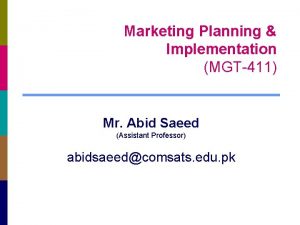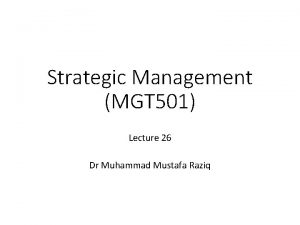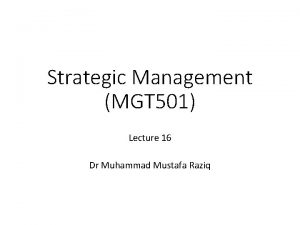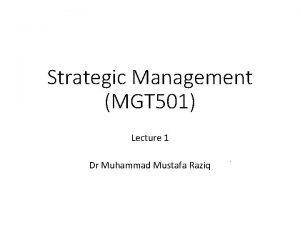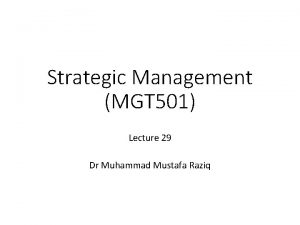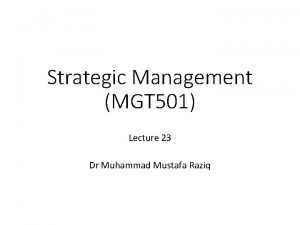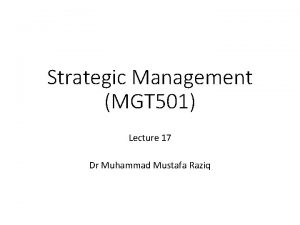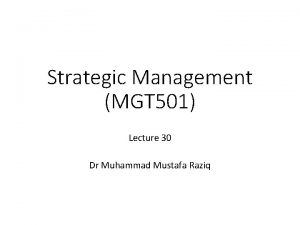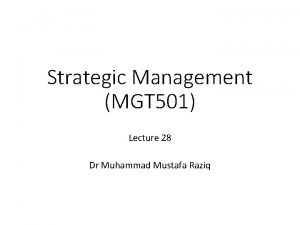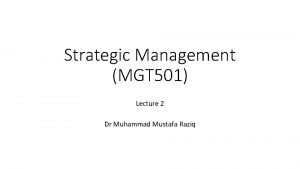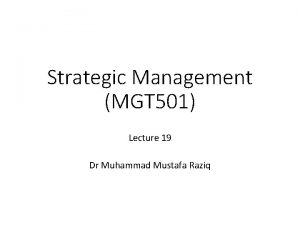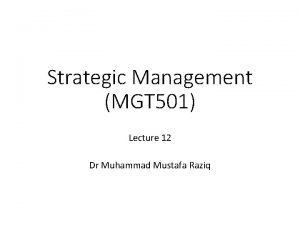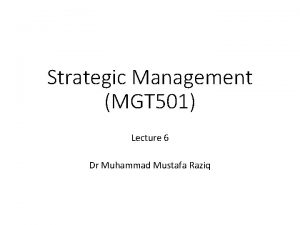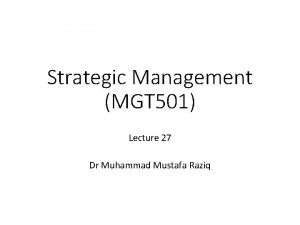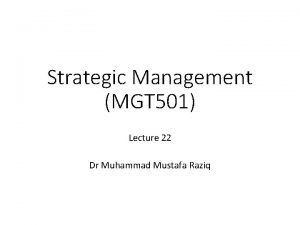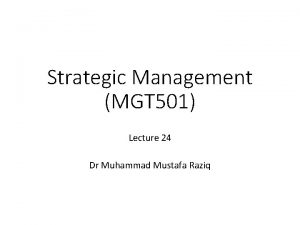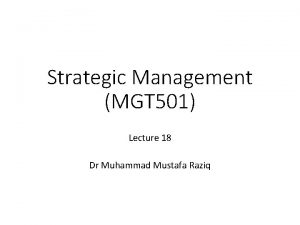Strategic Management MGT 501 Lecture 10 Dr Muhammad



















- Slides: 19

Strategic Management (MGT 501) Lecture 10 Dr Muhammad Mustafa Raziq

Topics to be covered in this lecture • Firm and Strategy • Elements of a Firm’s Strategy

Chapter 4: Mission, Vision, Strategic Objectives, and Business Model • 4. 1. Firm and Strategy • In the business world to understand strategy, the meaning of a firm should be understood first – a firm is a vertical chain of activities; it is a legal entity registered under an act or law – it is a business activity house with a group of people partnered together for a particular adventure or a particular undertaking – it is a place making something, that is goods or services. • Firms are entities or units producing economic value in goods or services and providing social benefits to the society by incurring some costs and bearing some risks. Firms primarily exist to secure the needs of persons who are outside its boundary. • Firm is a collection of human assets, the owners of which work so closely together that outsiders can not clearly distinguish one from the other.

4. 1. Firm and Strategy (continued) • The primary issue in strategy is how to organize the vertical chain: whether a single firm does all the activities or is it better to depend on independent firms in the market to do one or a few of the activities. • Thus performing an economic activity for the market gives rise to firms. • Strategy is vital to any firm primarily in choosing the economic activity in the value chain to pursue and secondly in having a sustainable competitive advantage. The primary issue of strategy generates mission, vision and business model of a firm, whereas the second issue generates distinctive capabilities.

4. 1. 1. Firm’s Need Hierarchy • As per Maslow hierarchy of needs in individuals, physiological needs come first and self actualization last – later researchers identify the first four needs as deficiency needs and the last one as growth need of an individual.

4. 1. 1. Firm’s Need Hierarchy (continued) • Applying this model to organization, growth with high risk taking, and high investment of time, efforts and money would happen if one is at the growth need level. At the deficiency need level, risk taking ability is constrained. Sustainability Growth Need Self Actualization (Mission Fulfilment) Esteem Needs (Recognition) Social Needs (Identity) Security Needs (Survival) Physiological Needs (Profits) Deficiency Needs

4. 1. 1. Firm’s Need Hierarchy (continued) • An Addition – Need for sustainability (Immortality and to be in the flow with the external environment) • Need for Growth (Realizing the full potential and mission fulfillment) • Need for Recognition (Esteem, Reputation, Legitimacy, and Visibility) • Need for Identity (Brand Image, Differentiation, and everyone knowing what the firm stands for) • Need for Survival (security need satisfied often by offensive and defensive strategies) • Need for Profits (physiological need satisfied by maintaining a positive cash flow)

4. 1. 2. Upstream and Downstream Activities • In the production process, activities starting with source and selection of raw materials are called upstream and later steps towards customer side are called downstream. • The vertical chain also involves many specialized activities called support activities such as accounting, finance, human resource management, R&D, planning and so on.

4. 1. 3. Boundary of a Firm • The vertical boundaries of a firm define the activities that a firm performs on its own as opposed to buying from independent firms in the market on contractual relationships. Therefore make or buy decisions define the vertical boundary of a firm. • There is an intermediate solution called ‘ally’ between make and buy in the form of strategic alliances and joint ventures. • Firms have corporate and horizontal boundaries as well – horizontal boundaries extent to the market space usually measured in terms of market share. Corporate boundaries define the number of businesses a firm is undertaking in the corporate domain.

4. 1. 4. Architecture of a Firm • Architecture of a firm is defined by its stakeholders and defined by its environment – a strategist designs a capable and a sustainable firm just like an architect designs a building. A firm designed without a good strategy is an incapable firm, as a building designed without a competent architect. • A capable firm would be termed as a valued firm. An incapable firm, which is poorly designed, can be transformed to a valued firm by crafting an appropriate strategy suited to the firm and its environment at the relevant time just as a professional architect remodels a building giving it new looks, better functionality, and durability.

4. 1. 5. Corporate Philosophies • The business mission and values espoused by the management or the broad or the founder are derived from the corporate philosophy. • It stands for the basic belief that the people in the firm are expected to hold and be guided by. These are unwritten, informal guidelines on how people should behave, perform and conduct themselves. • Corporate philosophy evolves as a set of law that gradually becomes established as expected patterns of behavior. • It furnishes the rational explanation of anything with respect to the firm, even though not written like a mission statement.

4. 2. Elements of a Firm’s Strategy • Understanding what are the components of a system or process or concept is best achieved by disaggregating it into its component parts and then aggregating all the parts back, that is, fitting, each element to its correct position. This is just like in military or police the young officers are taught about a weapon by first dissembling it and then reassembling it. • Similarly, the strategy can be understood easily by knowing its components

4. 2. Elements of a Firm’s Strategy (continued) • The first attempt to identify the components of strategy was made by Ansoff (1965), who identified the following four components: • The product and market scope of the firm • A growth sector specifying the anticipated changes in the firm’s present product market positions • Competitive advantage • Synergy • Mutual reinforcement of these four elements increases the firm’s probability of success. • Ansoff defines strategy as the common thread that gives a relationship between the present and future product markets, which would enable the outsiders to perceive where the firm is heading and the internal management to give its guidance

4. 2. 1. Essential Elements of Strategy of a Firm • Strategy can be disaggregated into ideas in different sequences which when activated through the decisions of managers at various levels result in actions and the visible performance is the end outcome. • The activation of the ideas may come from the stimulus of the external environment or from the internal environment or from other ideas residing within the firm. • Such stimuli results in decisions and prompting the idea to be expressed as actions. • The core of strategy is specific configurations of idea sets, which has potential to express themselves, once triggered by decisions by people who are stimulated by the internal or external environment of the firm or self-expressed by the power of idea sets themselves.

4. 2. 1. Essential Elements of Strategy of a Firm (continued) • The configurations of idea sets are created deliberately in many organizations as a part of strategic planning process, thereby resulting in a ‘plan’. • However, the decisions, actions, and performance of a firm need not be as per the strategic plan, as the plan is a configuration of certain idea sets put into paper or existing as mental model. • Thus, often the realized performance of a firm may not be as per the plan. • Sometimes there may or may not be a written plan, but the decisions are taken in a flow at various levels, thereby resulting in performance of the firm called as emergent strategy.

4. 2. 1. Essential Elements of Strategy of a Firm (continued) • Thus every firm has certain configurations of idea sets, and there is no case of strategy absence in any firm, but there may be absence of strategy expression and strategic plan. • To an outsider, a strategy is visible in its different manifestations as plan, position, process, creative people, practices of a firm, or the path taken by a firm, but essentially strategy is a configuration of idea sets residing within the firm, which may configure often in flexible organizations or may be fixed in rigid organizations.

4. 2. 2. Associated elements of strategy • Two views of Strategy: 1. 2. A strategy consists of a set of interrelated choices. The company’s mission and objectives stand apart from and guide strategy. Strategy addresses how the business intends to engage its environment and hence, choices about internal organizational arrangements are not a part of this strategy. Internal systems and programs should support and reinforce strategy, but they do not make up strategy The other view proposes that the elements of strategy are mission, vision, strategic objectives, business model (model including functions of a business, as well as the revenues and expenses), core values, strategy map (diagram showing goals being pursued by the firm), and strategy plan.

Topics covered in this lecture • Firm and Strategy • Elements of a Firm’s Strategy

Topics for the next lecture • Firm and Strategy • Objectives and functions of a strategy • Developing Strategic Vision and Strategic Objectives • Levels of Objectives • Organizational mission and mission statements
 Mgt 501
Mgt 501 Mgt 501
Mgt 501 Mgt 501
Mgt 501 Wa tu izzu man tasha in english
Wa tu izzu man tasha in english Attahiyyatu
Attahiyyatu Strategic management lecture
Strategic management lecture Strategic competitiveness
Strategic competitiveness Strategic analysis and choice in strategic management
Strategic analysis and choice in strategic management 01:640:244 lecture notes - lecture 15: plat, idah, farad
01:640:244 lecture notes - lecture 15: plat, idah, farad Mgt 323
Mgt 323 Scope of managerial accounting
Scope of managerial accounting Mgt 601
Mgt 601 Mgt 351 nsu course outline
Mgt 351 nsu course outline Mgt340 group assignment
Mgt340 group assignment Mgt 321 chapter 1
Mgt 321 chapter 1 Mgt 211
Mgt 211 A product can be mgt211
A product can be mgt211 Mgt 411
Mgt 411 Mgt 385
Mgt 385 Ecv expected commercial value
Ecv expected commercial value
